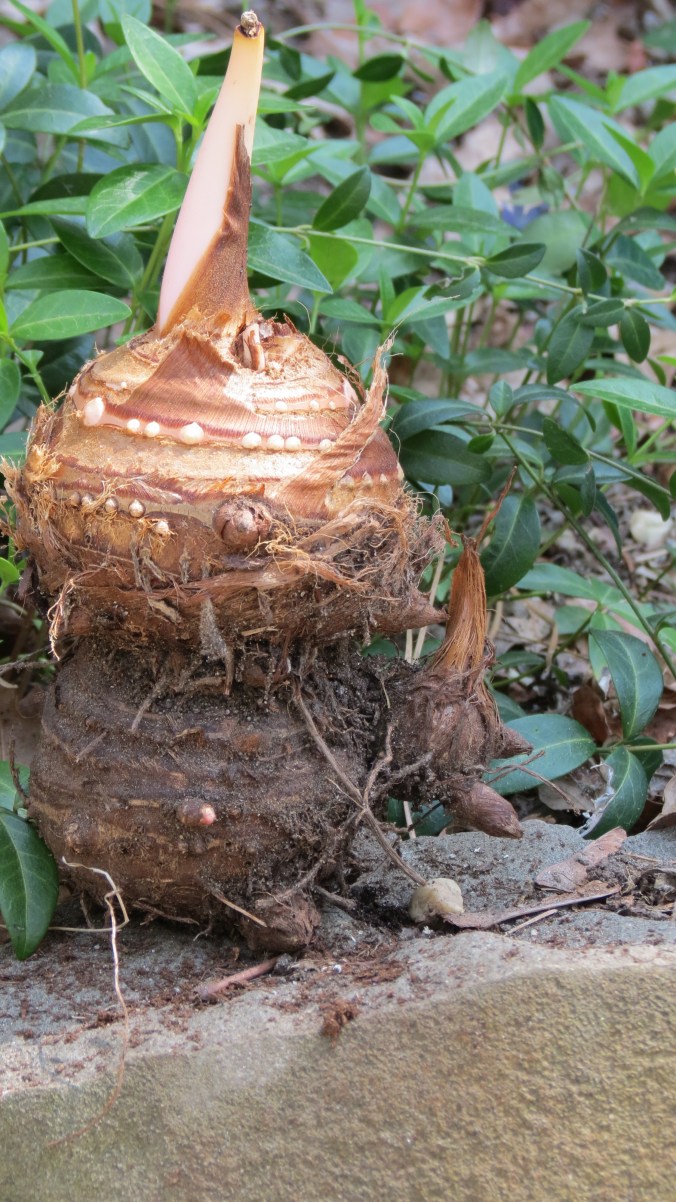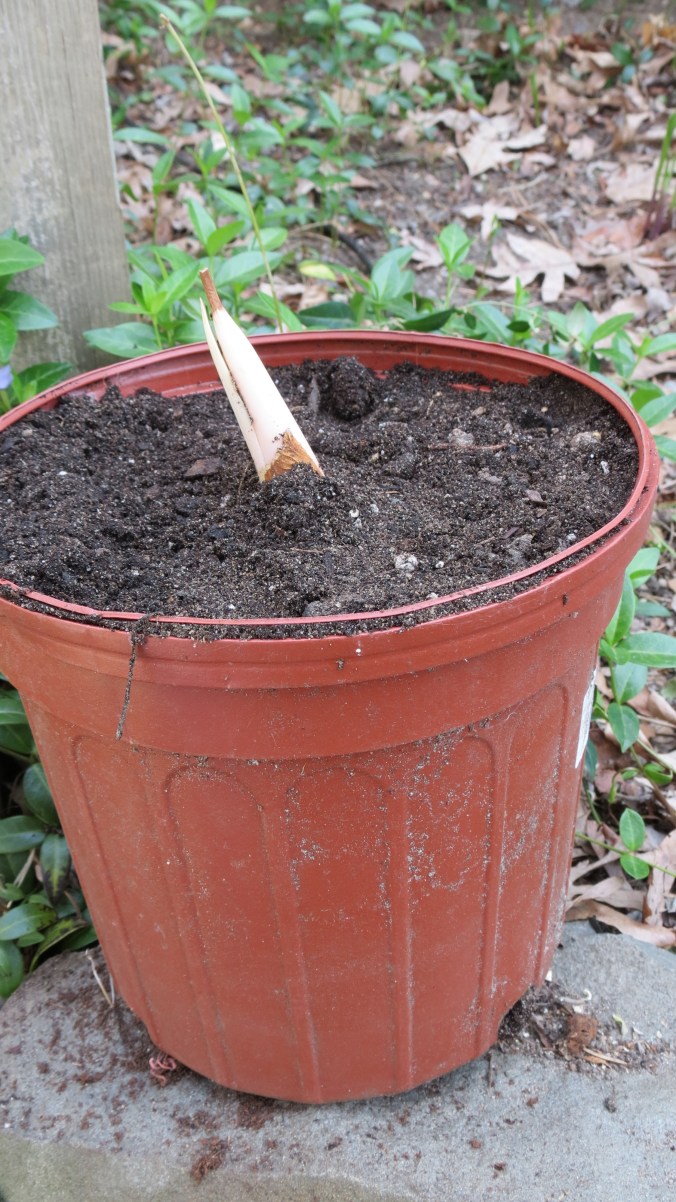Attractive, aren’t they?
The last time I saw my Elephant Ears, they were clipped back, packed into peat moss, and stored in a cement bunker. With the very warm April temperatures, I couldn’t resist opening up their winter palace. But unlike Geraldo Rivera and Al Capone’s vault, I found my treasure.
1. After a long winter’s nap, the stems, leaf remnants, and roots have withered from tropical green to paper bag brown.
2. To clean each bulb, I shake off the excess peat moss and dirt. Then, it’s time to husk the dead leaves, stems, and roots.
3. It takes a little effort, but once cleaned, there is usually a pinkish shoot at the heart of all that brown – the promise of new growth.
4. Some bulbs may still have healthy looking roots. These I leave on – might as well give the bulbs a head start once they’re planted.
5. This Elephant Ear collection began years ago with the purchase of one bulb. Over time, smaller bulbs developed, like the one pictured here (toward the right), and these can eventually be separated, either manually or on their own. I’ve also learned that the bigger the bulb, the larger the leaf. But the smaller bulbs also have value – they can be kept in pots and moved around the garden as filler.
6. To plant the bulbs, the toughest part is choosing the right sized pot. I add some potting soil to the pot, settle the bulb into place (shoot side facing up, of course), and then fill until the crown is just below the surface.
7. I’m sure I make more work for myself by first potting the Elephant Ear bulbs. With the pots, however, I feel I have more control over the plants. If there should be a frost, I can move the collection indoors. If a bulb fails to bloom, I won’t have an empty area in the garden.
8. Once planted, I place the pots in a sunny location and water daily. These are tropical, and they thrive on heat and moisture. Once they develop leaves, it’s into the garden they go – usually to a partial shade location.
A special thank you to Elaine from Ramblings from Rosebank for suggesting that I post a few photos of Elephant Ears in their glory days of summer.
Next Post: I Canna Believe It’s You









Shame you didn’t post a picture of what they look like once they are in leaf as I’ve no idea. Looks as if they might grow huge considering the size of the bulb. Congrats. on your 100th post.
Elaine, thanks for the suggestion! I’ve corrected the oversight with some photos from last summer. I hope the images encourage to try growing a plant or two or more. 🙂
Looking forward to seeing your Ears in all their glory later on in the year, are you spending more time these days on Post Titles than gardening? Canna wait til’ next tme x
🙂 I’m looking forward to some big greenery, as well. I canna believe it will be here soon!
Nice! Very informative..thank you!
So glad you enjoyed it.
Always wanted to try these. Nice to know that the bulbs can be overwintered rather easily.
Mario, I’m sure you can handle the task. It’s definitely worth a try. Hope all is well where you are.
I am lazy when it comes to my ‘one’ Elephant leaf bulb. I just take it and the pot into the basement each fall. LOL! I may have some little bulbs and not even know it.
There’s nothing wrong with lazy. 🙂 If I had a safe place in the house, I would do the same.
Kevin – what a great post (and funny title, as usual!) I love the look of Elephant’s Ears in gardens and now know that they can be over-wintered. Am looking fwd to seeing how they grow for you this summer.
That makes two of us. 🙂 They’re pretty much indestructible. About the only thing that will kill them is cold.
Glad to see you followed up on these as I’ve often thought about buying elephant ears but have no idea how to store them. I never would have thought to remove all the dead leaves.
Marguerite, go for it! When it comes time for storing them, cut the stems back to about 12″. Wear old clothing because Elephant Ears “bleed,” and the liquid will stain everything — permanently. Let them cure for a few days, and then pack them away in peat moss. They can then be stored in a dry, cool location, like a basement. They’re a pretty hardy bulb — except when it comes to winter’s cold.
My grandmother used to have elephant ears in her garden and I’ve always thought they were spectacular. I haven’t thought of them in a while…now where do I have room for them? But I do have canna coming up in all sorts of spots, year after year, and I love them. I never thought of how in colder climates you might have to dig up these bulbs. I really admire the work that has to go into winterizing your bulbs. Debra
Debra, I like to fool Mother Nature into thinking that I live in the tropics. The older I get, though, Mother Nature is having the last laugh. 🙂
Congrats on your 100 milestone 🙂
And thanks for posting the pics of the full grown leaves, I was wondering what to expect and what do you know, an elephants ear! Beautiful!
Many thanks — and I hope you take a chance on Elephant Ears.
Do elephant ears need to be taken out of the ground in the winter and replanted in the spring? I planted several for the first time last year, and left them where they were all winter. I did notice one rotted, but half of the others appear to be coming up again.
I think that’s a combination of climate zone and gambling. Where I live (Zone 6/7), I have to either dig them up and store them for the winter or, if they’re in a pot, bring the whole thing inside. In warmer climates, they can be left in the ground — but if there’s a deep freeze, they could be wiped out. If you need to replace the one that you lost, you could probably dig up a survivor and there could be smaller bulbs attached to the mother bulb. Good luck with it. . .
I suspect I should be digging them up. I’ve only got half the ears coming up so far. Must have lost a few.
It’s tricky when growing tropicals in the non-tropics. I’ve tried keeping some in the ground in areas that receive full sun all winter, plus a layer of mulch — anything to keep the soil warm. The results have always been mush. So far, the labor intensive way seems to work best. Good luck with them!
Now they are colossal leaves. Glad it was suggested to put in the last images.
They are large — and they always bring a smile to my face. Close-up, the leaves are quite stunning — swirls of shades of green.
Wow, those are huge beautiful leaves!
And they’re fun. I hope to get some close-up photos of the green swirls in their leaves.
Oh, I love elephant ears! I used to have them in the garden, but they became a casualty of my “rearranging.” I love the movement elephant ears provide; the way they seem to float. They also give the garden such pizazz with those fabulous leaves. Now, I’m trying to figure out where to fit some in again. I enjoyed your post and congratulations on it being your 100th! 🙂
I know the floating of which you speak! I like to walk by a row of Elephant Ears and bounce my fingers from leaf to leaf. Hope you can make some room!
Hi, I’ve been reading and browsing on your posts, as it is just my first time here. I love your posts. If i may, i just would like to correct a misnomer term here as you called the elephant ear’s storage organ a bulb. It definitely looks like a bulb at the outside, but it is not a bulb but a corm. A bulb like the onions is a layer of leaf sheats and the shoot is at the middle. On the other hand, a corm is a solid compact base of the leaves, just like the taro, which as ornamentals is called elephant ears. I hope you don’t mind my meddling here, as nobody in the commenters suggested the right term. thanks.
By the way, here in the tropics where taro originated, those 3 corms of your plant can be separated to 3 plants and they will individually grow as one. We sometimes divide the corms to many pieces and each piece also grow. It is very easy to grow here.
On the contrary, that’s one of the things that I’ve enjoyed about writing this blog — the chance to learn and to expand my own knowledge base. Many thanks for the correction and the advice. I hope you keep returning to the site — and if you see an error, I welcome the correction. 🙂
I have potted elephant ears I move in every fall. During the summer, twice now since I’ve had them. They have produced shoots that look like pods, inside filled with what looks like tiny seeds. Can you plant these to produce z plant?
Congratulations on the seeds! I’ve never had that happen, so I’m not too familiar with the process. I did, however, do some research — and this link might help: http://www.aroid.org/horticulture/araceae_seed_sowing.php
Good luck with it!
how do you manually divide them safely as not to harm either of the bulbs? I have elephant ears and typically every 3 years (late fall) I dig them up and put them in a brown paper bag and over the course of the winter they divide into two or 3 bulbs but can I dig them up and divide them in the spring safely?
Hi MJ. When I was in zone 6/7, I had to dig my elephant ears each year. After winter storage, I would bring them out into the light of day. By that time, the bulbs had dried out so that could easily be separated. I could practically shake them apart. Thanks for your question — I hope this helps . . .